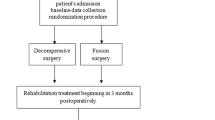Abstract
Presented here is a prospective study assessing the efficacy of decompression of concomitant noncontiguous level (thoracic & lumbar) stenosis in accordance with neurological findings, nerve root blocks, and myelographically proven disease. The objective was to determine the efficacy, clinical outcome, and functional recovery in patients undergoing simultaneous decompression. No previous study has focussed on the clinical outcome of such simultaneous decompression. Twenty-one patients with neurological claudication, progressive gait disturbance, upper motor neuron symptoms, and findings of myelopathy in both the lower extremities underwent simultaneous decompression and were assessed. The average follow-up was 32 months (range, 24–40 months). At the last examination,13 patients (82%) had excellent or good clinical results. Postoperative improvement correlated inversely with the duration of symptoms. The patients usually had satisfactory outcomes when the correct diagnosis was made and management was implemented. Functional recovery depends on early diagnosis and timely surgical intervention.
Résumé
Une étude prospective permettant d’évaluer l’efficacité de la décompression concomitante pour canal lombaire étroit au niveau thoracique & lombaire à différents étages, avec signes neurologiques, a été réalisée. L’objectif était de déterminer l’efficacité et le devenir clinique et fonctionnel après cette décompression. Aucune étude de la littérature n’a analysé le devenir clinique pour de telles décompressions simultanées. 21 patients avec une claudication intermittente neurologique et une diminution du périmètre de marche avec douleur radiculaire et des signes de myélopathie au niveau des deux membres inférieurs ont bénéficié d’une telle décompression simultanée. le suivi moyen a été de 32 mois (de 24 à 40 mois). Au dernier examen, 13 patients (82%) avaient un excellent ou bon résultat. La récupération post-opératoire est inversement proportionnelle à la durée de la symptomatologie. les patients ont eu un résultat satisfaisant, le diagnostic et le traitement ont été réalisés de façon correcte avec une bonne récupération fonctionnelle qui est dépendante d’un diagnostic précoce et de l’algorithme chirurgical.




Similar content being viewed by others
References
Barnett GH, Hardy RW, Little JR et al (1987) Thoracic spinal stenosis. J Neurosurg 66:338–344
Chang UK, Choe WJ, Chung CK, Kim HJ (2001) Surgical treatment for thoracic spinal stenosis. Spinal Cord 39:362–369
Epstein NE, Schwall G (1994) Thoracic spinal stenosis: diagnostic and treatment challenges. J Spinal Discord 7:259–269
Marzluff JM, Hungerford GD, Kempe LG (1979) Thoracic myelopathy caused by osteophytes of the articular processes. Thoracic spondylosis. J Neurosurg 50:779–783
Miyasaka K, Kaneda K, Ito T et al (1982) Ossification of spinal ligaments causing thoracic myeloradiculopathy. Radiology 143:463–468
Okada K, Oka S, Tohge L et al (1991) Thoracic dyelopathy caused by ossification of the ligamentum flavum: clinicopathological study and surgical treatment. Spine 16:280–287
Omojola MF, Cardoso ER, Fox AJ (1982) Thoracic myelopathy secondary to ossified ligamentum flavum. J Neurosurg 56:448–450
Sato K, Kikuchi S (1997) Clinical analysis of two-level compression of the cauda equine and the nerve roots in lumbar spinal canal stenosis. Spine 1522(16):1898–1903
Takeuchi A, Miyamoto K, Hosoe H, Shimizu K (2004) Thoracic paraplegia due to missed thoracic compressive lesions after lumbar spinal decompression. Report of three cases. J Neurosurg 100:71–74
Yamamoto I, Matsumae M, Ikeda A et al (1998) Thoracic spinal stenosis: experience with seven cases. J Neurosurg 68:37–40
Author information
Authors and Affiliations
Corresponding author
Rights and permissions
About this article
Cite this article
Gupta, A., Dave, B., Nanda, A. et al. Concomitant noncontiguous level (thoracic & lumbar) spinal stenosis. International Orthopaedics (SICOT) 33, 483–488 (2009). https://doi.org/10.1007/s00264-008-0545-8
Received:
Revised:
Accepted:
Published:
Issue Date:
DOI: https://doi.org/10.1007/s00264-008-0545-8




